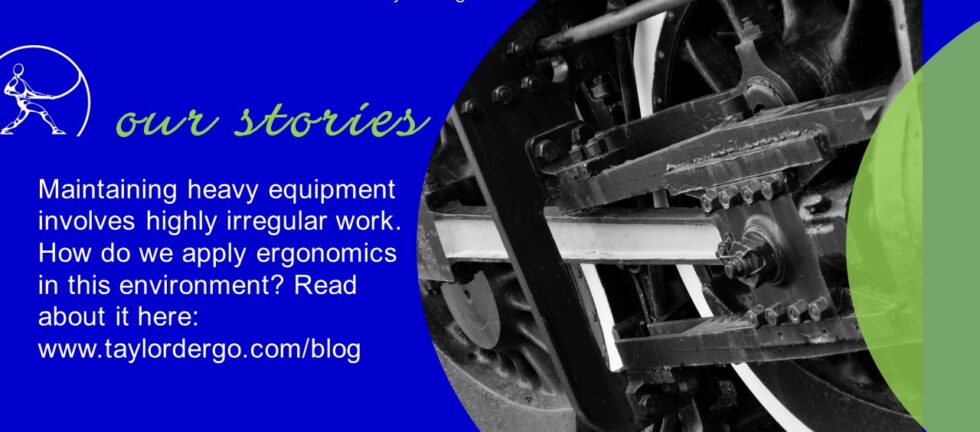Carter has been working with clients who maintain heavy transportation equipment. Our team can confirm that these lessons apply not just for planes and trains, but also for automobiles buses and construction equipment. Read on to learn about how we’ve tackled some sector-specific challenges.
How is this sector unique?
Most of the work is self-paced with very tight deadlines. Facilities prioritize work orders based on the release of the equipment, preventative maintenance schedule, and service requests to address specific issues. Scheduled maintenance and service tasks are the most routine work, and the easiest for us to observe. More experienced workers typically perform the less frequent tasks, which often involve more problem solving. These irregular tasks are harder for us to see, because they are typically not planned in advance.
Collecting data in this environment is difficult – specific tasks occur infrequently, under time-pressure. Many processes can be performed in a variety of ways. Ideally, observing multiple people perform a job allows a better understanding of the demands and variability. Engaging with more workers ultimately leads to more accurate data and a better solution.
What approaches have worked best for you?
From an ergonomics standpoint, it’s important to build relationships with workers in all departments and understand everyone’s roles, so we can find solutions that work for everyone. Understanding the organizational structure also helps us to find information more readily (inspection criteria, work rates, scheduling plans, etc.) Electricians, maintenance workers, and technicians have separate responsibilities, but work together on some tasks. In a service facility, the changes that we suggest for one job may impact stakeholders in multiple departments (stores, packaging, scheduling, etc.).
What are the biggest ergo challenges in this sector?
Physically demanding tasks that may be worrisome happen so infrequently, they are often overlooked, and are usually hard to observe. Extra planning is required to see a specific task, and when that task occurs, we have to prioritize it above all else.
After analysis, getting support to change a rare but high-risk task can be difficult. We try to find solutions that also apply to other tasks that happen more often. For example, a lifting device that is really critical for a rare high-risk task should also be useful for more common, less demanding tasks.
What advice would you give to someone who is responsible for musculoskeletal disorder (MSD) prevention in this sector?
Because each worker performs a broad range of tasks, an assessment of a full “job” will take longer to complete. It’s important to collaborate with supervisors for scheduling. Prioritize the highest risk jobs first, but understand that tasks that are performed rarely will always jump the queue – we have to collect the data when the job is performed.
If you can access strain/sprain injury statistics, try to identify tasks that have been associated with strain/sprain injuries. Interview workers and supervisors to identify the most physically demanding aspects of the job. Workers typically dislike performing tasks with strain/sprain hazards, and novice workers often have the most difficulty on these tasks. Workers and supervisors can usually tell you which tasks are “hard” or “unpleasant”!
Independent work and time-pressure
A maintenance facility’s time-pressure changes how we schedule observation, as well as how we collect the data. If a worker is performing a task under time-pressure, the ergonomist accumulates questions and engages with the worker after the task is completed, rather than interrupting the workflow. Workers typically have some time available between tasks, and are willing to share their concerns and ideas during these gaps in the day.
Solutions that improve efficiency will always be welcome for deadline-driven work. Understanding this time-sensitivity can help us to cost-justify an ergo intervention. On a process that can only be performed when equipment is out of service, a change that reduces task time will receive more support than a change meant to reduce the risk of strain/sprain injuries.
Micro-learning – “Ergo talks” can give employees tools to reduce their risk of MSD
Carter has piloted a few of our new micro-learning modules in these workplaces with very positive feedback. In any environment where tasks can be very awkward and very heavy, employees should use “ergo work strategies” to optimize their strength.
As an example, when pushing or pulling a wrench, foot placement can make a huge difference in the ability to generate force. Carter provided “All about the Base” micro-training to small groups of employees throughout the facilities, to help them to experience and understand the effect of good foot placement when applying pushing efforts.
What is “micro-learning”? Our micro-learning modules are 5-minute in-person sessions that focus on a specific work strategy for a specific task.
- The facilitator reviews the common practice, and describes and demonstrates how and why the ergo work strategy works.
- The participants perform an activity that “proves” that the strategy works, and they discuss how it applies in their workplace.
As we’ve mentioned before, we believe that the hands-on part is the key to successful micro-learning; when participants can feel the difference that a strategy makes, they will remember and use it in the workplace. These practical exercises are tricky to develop and require testing, but they transform the sessions from “awareness” to “skill-building”.
We’re in the process of creating and piloting a library of micro-learning modules that will be available on a subscription basis. We will offer modules aimed at specific sectors, including long-term care, paramedics, industrial work, custodial, distribution, drivers, and office work. We’re partnering with a few clients to gather data from employees to prove that this approach works; if you’re interested in becoming a pilot site for a specific task, please contact carrie@taylordergo.com.


